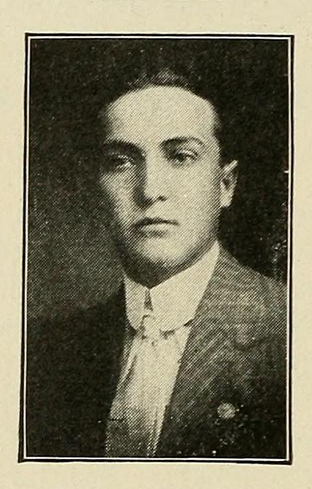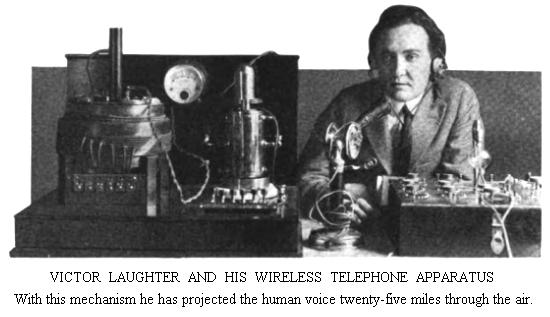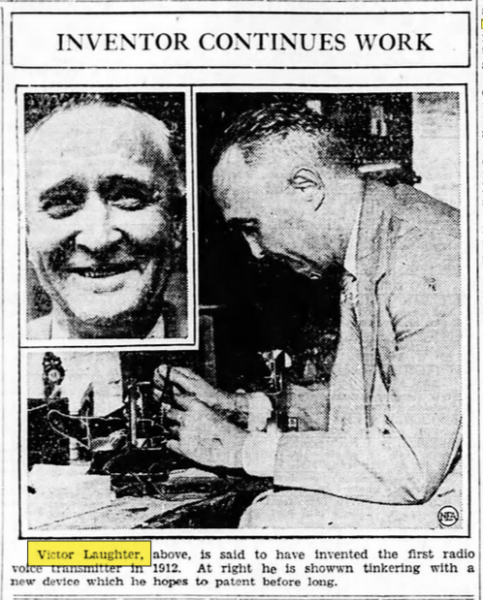
While I was being distracted by the little known 1909 precursor to solar panels when helping researchers, I noticed something else in Popular Electricity in Plain English that astonished me. One of the authors who had written about Cove’s sun harnessing experiments, Victor Laughter, had also been written about for his own experiments in wirelessly transmitting photographs in 1910! A quick search online for Victor Laughter provided none of the usual answers, no Wikipedia entry, no casual mention to his inventions. So, of course, I had to find out more.
Victor Laughter was born in Mississippi in 1988 and by twelve was likely orphaned living in the Waverly Institute, along with his sister Belva (Bensman, n.d.). Also around the age of 12, Laughter built his first experimental wireless set (Bensman, n.d.). Belva would marry and move to Memphis, making Memphis the home to which Victor would often return before residing their permanently. He would perfect and advertise his wireless telegraphy set when he was twenty (‘Inventor Tells About First Set,’ 1931), quickly following this with the publication of his book the Operator’s Wireless Telegraph and Telephone Handbook published by Drake and Company in 1909. It was the most complete guide to wireless at the time, now believed to be the first book on radio (‘Victor Laughter, Radio Pioneer, Dies,’ 1966), and would sell over 30,000 copies over two printings (Bensman, n.d.).

Before getting too much further, it will be useful to understand the state of radio at the turn of the 20th century. Prior to 1920, radio, known as wireless, was extremely experimental. Most wireless telegraphy, later radiotelegraphy, prior to WWI was morse code that would turn the transmitter on and off producing the dot and dash pulses of radio waves. The waves being sent and received could not carry a voice until Reginald Fessenden invented the heterodyne receiver in 1901 (Wireless Telegraphy, 2023). Wireless telegraphy became an exciting new hobby and challenge for anyone with the time and access to equipment needed (Halper, 1999). These hobbyists made important discoveries and advancements that would cement radio’s importance in the upcoming war and as a commercially lucrative opportunity thereafter.
In 1910 Victor Laughter would take on the position of editor for Hugo Gernsback’s Modern Electrics magazine, all the while publishing consistently in Popular Electricity in Plain English and serving as Technical Director and Secretary for the American Wireless Institute of Detroit (Bensman, n.d.; Massie & Perry, 2002). His wireless transmission of photographs was highlighted in the Popular Electricity in Plain English 1910 article: “Transmission of Photographs by Wireless.” This invention, which would be an early example of a facsimile transmission, isn’t mentioned much elsewhere and may have been an experiment that was left by the wayside similar to those described by McCormack (1913):
“In later years other experimenters tried to develop improved high-frequency spark transmitters–Victor Laughter himself wrote an article about William Dubilier’s efforts along these lines in the June, 1911 Modern Electrics. (A second article on Dubilier appeared in the January, 1912 issue–this time followed two months later by a letter from Laughter, complaining that Dubilier was now claiming credit for a transmitter design actually developed by Laughter). And in spite of the optimism Laughter expressed in this article about the future of his system, no high-frequency spark system for audio transmissions was ever developed to the point that it was successfully put into commercial service.”
McCormack, Edward J. (1913). A Voice From The Air. Technical World Magazine. 84-85. The Voice From the Air (1913) (earlyradiohistory.us)

Victor Laughter would also transfer or sell most of his invention patents to various companies and organizations (‘Inventor Tells About First Set,’ 1931). His first three patents, prior to 1911, were sold to Dr. Lee DeForest of the North American Wireless Corporation which would soon after go bankrupt, transferring all assets to the Radio Corporation of America (Bensman, n.d.). So the further development of many of his ideas would end up in the hands of others. He seemed most committed to developing and improving wireless broadcasting. In 1913 he had arranged to set up his equipment on the roof of the Tri-States station in the Falls Building in Memphis. Laughter called the press to his experiment testing the area limits of a broadcast and had more reporters and his brother in law waiting at a house two miles away (McCormack, 1913; Bensman, n.d.; ‘Victor Laughter, Radio Pioneer, Dies,’ 1966). Victor Laughter would also be credited with one of the first broadcasts of a live performance by W.C. Handy, the Father of the Blues, in 1914 (Halper, 1999).
“Our research during the war aided materially in the commercial development of the industry. The Superheterodyne was the work of our development”
Victor Laughter (‘Inventor Tells About First Set,’ 1931)
In 1917 Victor Laughter was mustered into the army, where he would work in the U.S. Signal Corp. as a First Lieutenant and keep radio communication the the front lines in operation until 1919 (‘Inventor Tells About First Set,’ 1931; Bensman, n.d.). After the war he worked in St. Louis and Memphis doing a variety of jobs, dealing radio parts, and helping the design of Clarence Saunders’ first automated grocery (‘Inventor Tells About First Set,’ 1931; Bensman, n.d.). He continued to patent inventions which he invariably assigned to other parties. By 1931 he had 18 patents, and by his death in 1966 he had 25. He also continued to work with Hugo Gernsback’s and to contribute articles to Radio Electronics magazine, the successor to Modern Electronics (‘Victor Laughter, Radio Pioneer, Dies,’ 1966; Bensman, n.d.).
Volumes of Popular Electricity in Plain English can be found in the Smithsonian Libraries and on the Internet Archive .
Selection of Articles by Laughter:
- Laughter, Victor. (1908). Wireless Telegraphy Made Simple: Part 1. Popular Electricity in Plain English. vol.1 iss.1 pg. 32
- Laughter, Victor. (1908). Wireless Telegraphy Made Simple: Part 2. Popular Electricity in Plain English. vol.1 iss.2 pg. 82
- Laughter, Victor. (1908). Wireless Telegraphy Made Simple: Part 3. Popular Electricity in Plain English. vol.1 iss.3 pg. 138
- Laughter, Victor. (1908). Wireless Telegraphy Made Simple: Part 4. Popular Electricity in Plain English. vol.1 iss.4 pg. 229
- Laughter, Victor. (1908). Wireless Telegraphy Made Simple: Part 5. Popular Electricity in Plain English. vol.1 iss.5 pg. 296
- Laughter, Victor. (1908). Construction of a Two-Mile Wireless Outfit. Popular Electricity in Plain English. vol.1 iss.7 pg. 418
- Laughter, Victor. (1909). Wireless Telephony by the Fessenden System. Popular Electricity in Plain English. vol.1 iss.10 pg. 638
- first appearance of Wireless Queries column (answered by V.H. Laughter) 1909 Popular Electricity in Plain English. vol.1. iss.10 pg 640
- Laughter, Victor. (1909). Spark Coil Construction and Operation: Part 1. Popular Electricity in Plain English. vol.2. iss. 1 pg. 32.
- Laughter, Victor. (1909). Spark Coil Construction and Operation: Part 2. Popular Electricity in Plain English. vol.2. iss. 2 pg. 104.
- Laughter, Victor. (1909). Spark Coil Construction and Operation: Part 3. Popular Electricity in Plain English. vol.2. iss. 3 pg. 172.
- Laughter, Victor. (1909). Spark Coil Construction and Operation: Part 4. Popular Electricity in Plain English. vol.2. iss. 4 pg. 241.
- ?last appearance? Wireless Queries column (answered by V.H. Laughter)Popular Electricity in Plain English. vol.2. iss.4 pg 247
- Laughter, Victor (1910). Generating Electricity by the Sun’s Rays. Popular Electricity. 2(12): 804. https://archive.org/details/popularelectrici02chi/page/804/
- Laughter, Victor (1910) You Can Install Your Own Outfit for Wireless. Chicago Tribune. 11 Sep 1910 P26
- Laughter, Victor (1911) Dubilier’s System of Wireless Telephony. Popular Electricity in Plain English. vol.4 iss. 4 pg. 372.
References
- Bensman, Marvin R. () Radio Pioneer: Victor H Laughter. https://libjournals.mtsu.edu/index.php/tcaj/article/download/936/773/2581
- Halper, Donna. (1999) African Americans and Early Radio. African Americans And Early Radio (otrr.org)
- Inventor Tells About First Set (1913). Battle Creek Enquirer. 13 Sep 1931. pg 17
- McCormack, Edward J. (1913). A Voice From The Air. Technical World Magazine. 84-85. The Voice From the Air (1913) (earlyradiohistory.us)
- Massie, K. & Perry S. (2002) Hugo Gernsback and Radio Magazines: An Influential Intersection in Broadcast History. Journal of Radio Studies. 9(2): 264-
- ” Transmission of Photographs by Wireless” (1910) Popular Electricity in Plain English. v.1 n.1: p 254
- Victor Laughter, Radio Pioneer, Dies. (1966) Memphis Press-Scimitar, Friday September 30, 1966
- Wireless Telegraphy. Wikipedia. https://en.wikipedia.org/wiki/Wireless_telegraphy
